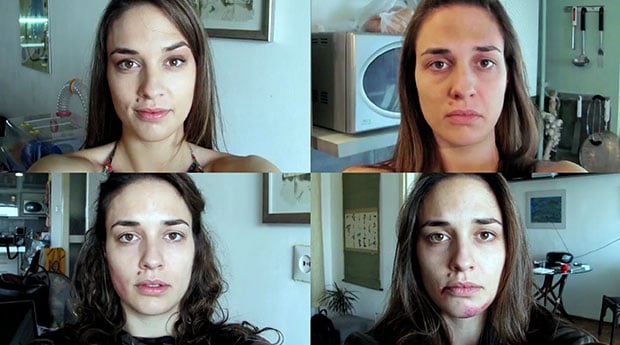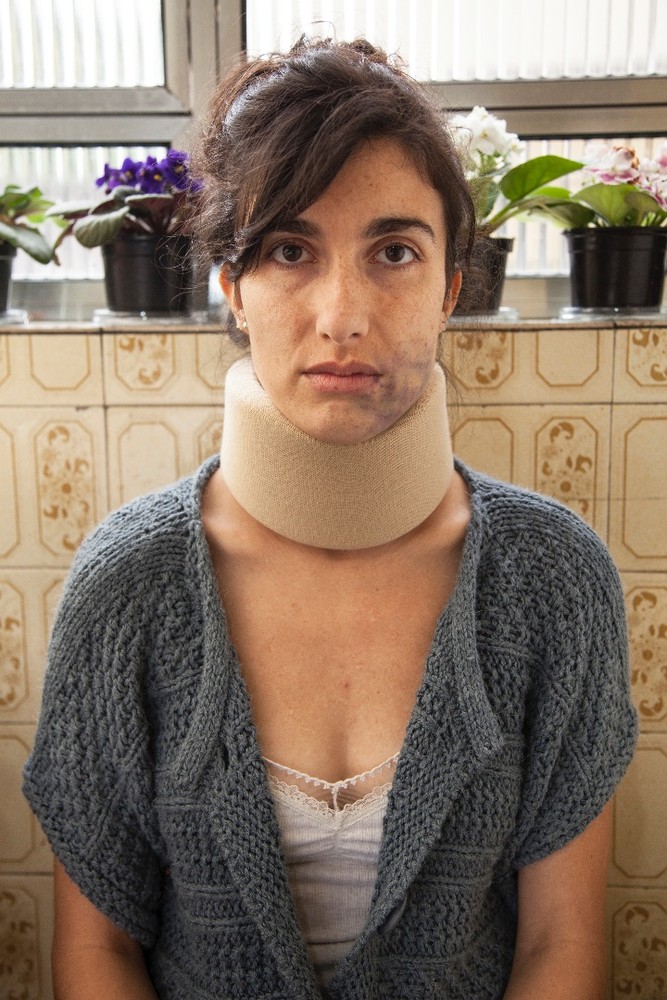As well as looking into documentary photography, I have decided to look at staged photography. I find that this topic is particularly interesting and when researching into it, I found a photographer called Jeff Wall who’s work I find quite interesting. Although Jeff Walls differentiates contextual from what I would do, there is something about his style of work that captivates me. When considering my own work, I would consider contextually focusing on the issue of domestic abuse an thus create staged images representing particular situations victims have been through/are still going through. The video below is about Jeff Wall explaining further into his style of photography. He states that staged photography is a way in which is expressive and challenges social conventions. It can be conducted in order to analyse or descriptively access an analytical point of view, in order fully comprehend the audacity and severity of specific subjects. I find his work particularly interesting due to the fact that he portrays essences of documentary styled photography in a manner that visually represents that of a documentary style.
master.m3u8
“In my time, I’ve been accused of being afraid to go out into the world to take pictures, like a so-called ‘real’ photographer does,”- Jeff Wall
Inspirations for topics to look at through the use of lens culture website:
-an interesting concept could be to produce work representing the fact that society is begging to take over our lives in a negative manner. Could represent the fact that a lot of children don’t actually know what to do with their lives and how most have perhaps forgotten the joys of being and playing outside: https://www.lensculture.com/articles/dan-wood-suicide-machine-is-bridgend-really-the-town-with-no-hope#slide-7 c543d099-5e53-4c5a-978b-80f52ae5fa13.jpg
-I quite like this concept of this is not real life as I find that we all have different views and opinions on what is real life and what isn’t. This idea could be represented in many different manners, from photographing everyday life, to everyday situations. https://www.lensculture.com/articles/dominika-gesicka-this-is-not-real-life …4325244c-29ca-4e2d-a8c3-e734f42a9c77.jpg
After conducting my research, I have found interest in a few different particular topics.
The first being The focus on truth behind relationships, and the truths being hidden in fear of someone. Focusing on domestic abuse is of particular interest for me because I find it such an emotional topic and the fact that many people are being victimised every day is horrifying. I also connect personally to this topic as I have a friend who has opened up and told me about her past abusive relationship, as well as two family members being affected by this issue. I would want to represent things that they have told in the manner of staged photography and for now, I plan on using myself as the subject.
Story to look at in more depth…
http://thebaffler.com/blog/battered-women-behind-bars-true-stories-on-stage
Artist to look at: Donna Ferrato
-http://www.donnaferrato.com/work -http://www.iamunbeatable.com/the-archive/
Online, I came across an article which talks about ways to bring awareness to domestic abuse. Although my outcomes would look very different from the ones below, it sort of allows people to see the negative emotional and physical impact of domestic abuse, and this is something I would want to portray throughout my images.
Uploaded by YouTube user fero061982 , the video is titled “One photo a day in the worst year of my life.”

This is an extract from the page that explains what the project is about:
It starts out like all the other photo-a-day projects: we see a woman who apparently faithfully snapped one mug shot each day. As the video progresses, however, we start noticing that something is off. Bruises begin to appear and disappear from the woman’s face, with the injuries becoming progressively more serious. At the end, we discover that the whole thing is actually a Croatian public service announcement that’s meant to draw attention to the widespread problem of domestic violence. The sign held up at the end reads: “Help me, I do not know if I can wait for tomorrow.” No one was actually hurt in the making of the photographs and video (all the injuries you see were created with makeup), and the video is simply one that takes advantage of an online fad/meme to make a powerful point.
The Second topic that I would be interested in looking at would be landscapes. I quite like the simplicity within the images and the geometrical lanes and shapes within the images are quite fascinating and i feel like i could produce/replicate something similar. Jersey is quite known for its spectacular sunsets, however I like how these images are in black and white emphasising the fact that even though the pink and blue skies aren’y visible, it’s still breathtaking.
https://www.lensculture.com/articles/yvonne-boyd-rise-and-fall



4a575a217ce5b74910fe610122a31fbb-large.jpg
Lastly, the third topic I find interesting is this idea of reflections. I like this concept, and what is the truth in reflections?This has spiked an interest from me and i plan on experimenting this idea with inspiration from Lee Friedlander. I find his work particularly interesting as he creates imagery with a sense of abstraction, and I also find quite interesting how he decided to include himself in someway , shape or form. This could be something to apply when experimenting with this idea.
“It fascinates me that there is a variety of feeling about what I do. I’m not a premeditative photographer. I see a picture and I make it. If I had a chance, I’d be out shooting all the time. You don’t have to go looking for pictures. The material is generous. You go out and the pictures are staring at you.”
http://www.dodho.com/lee-friedlander-reflections-of-the-street/














